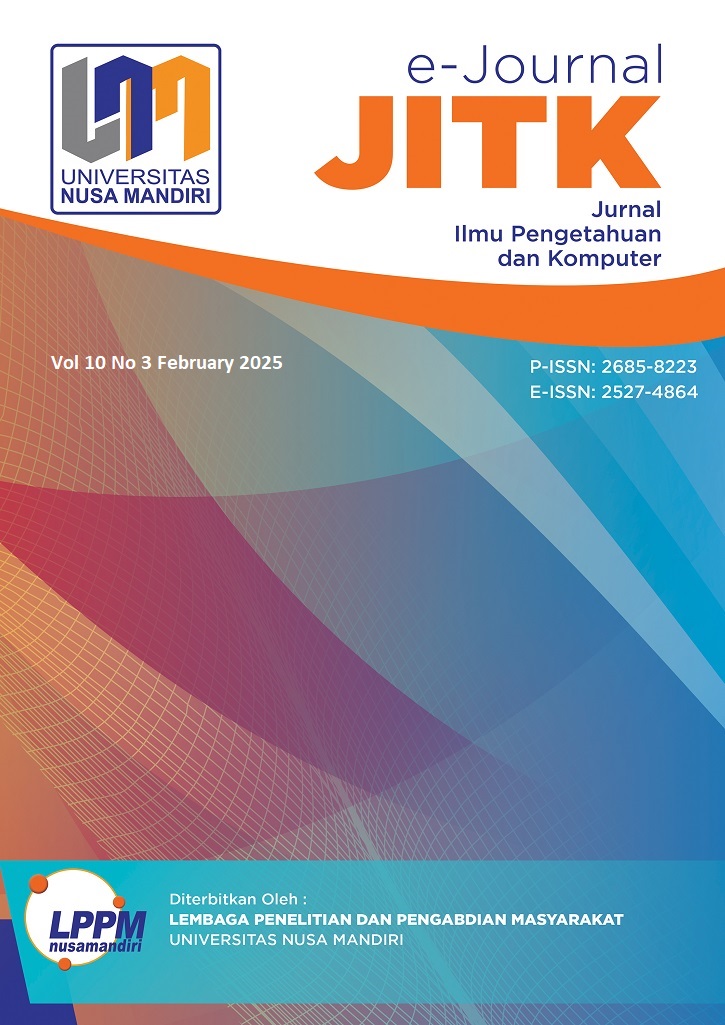PREDICTION OF INHIBITOR BINDING AFFINITY AND MOLECULAR INTERACTIONS IN MPRO DENGUE USING MACHINE LEARNING
DOI:
https://doi.org/10.33480/jitk.v10i3.5994Keywords:
binding affinities, dengue virus, machine learning, molecular docking, NS2B-NS3 proteaseAbstract
The dengue virus experiences rapid mutation and genetic variability, posing challenges in developing effective antiviral therapies. This study explores the prediction of binding affinities between potential antiviral drug inhibitors and the NS2B-NS3 protease of the dengue virus using machine learning models. Molecular docking simulations were conducted with AutoDock Vina to generate interaction data between viral proteins and ligands. The generated datasets were used to train several machine learning models, including Random Forest Regressor (RF Regressor), Support Vector Regression (SVR), and Extreme Gradient Boosting Regressor (XGBoost Regressor). The RF Regressor model demonstrated the highest accuracy in predicting binding affinities, measured through Mean Absolute Error (MAE), Root Mean Squared Error (RMSE), and Pearson Correlation Coefficient (R). However, the XGBoost Regressor and SVR models showed better generalization in practical scenarios. This study highlights the potential of machine learning to optimize the drug discovery process and provides significant insights into antiviral drug development for dengue fever.
Downloads
References
Ministry of Health of the Republic of Indonesia, “Infografis P2P,” Pusat Promosi Kesehatan dan Pemberdayaan Masyarakat, Kementerian Kesehatan Republik Indonesia. Accessed: Mar. 02, 2024. [Online]. Available: https://p2pm.kemkes.go.id/pages/publikasi/infografis
Gauri, L. A., Bhatnagar, K., Sameja, P., Nehara, H. R., Saini, K., Dutt, R., Bhatnagar, B., Khokhar, M. S., Kumar, V., and Garg, A., "Hematological indices as predictors of mortality in dengue shock syndrome: A retrospective study," Journal of Acute Disease, vol. 11, no. 4, pp. 150-155, 2022.
M. S. Valdés-Tresanco, M. E. Valdés-Tresanco, P. A. Valiente, and E. Moreno, "AMDock: a versatile graphical tool for assisting Molecular Docking with Autodock Vina and Autodock4," Biology Direct, vol. 15, no. 1, pp. 1-12, 2020.
J.-P. Quek et al., “Dynamic Interactions of Post Cleaved NS2B Cofactor and NS3 Protease Identified by Integrative Structural Approaches,” Viruses, vol. 14, no. 7, p. 1440, Jun. 2022.
F. G. Saqallah, M. A. Abbas, and H. A. Wahab, "Recent advances in natural products as potential inhibitors of dengue virus with a special emphasis on NS2b/NS3 protease," Phytochemistry, vol. 202, p. 113362, 2022.
A. Batool, N. Kanwal, M. Akram, S. Rauf, M. T. Navid, F. Masood, and L. Ali, "Molecular characterization and expression analysis of NS3 and NS4 genes of dengue virus serotype-2 from Pakistani isolates," 2023.
D. A. Pratiwi, R. Puspitasari, and A. Budiman, "Prediksi Ikatan Obat pada Protein NS2 Dengue dengan Machine Learning dan Docking Molekuler," Jurnal Ilmiah Farmasi, vol. 10, no. 1, pp. 1-10, 2020.
R. Puspitasari, A. Budiman, and D. A. Pratiwi, "Deteksi Dengue dengan Analisis Antibodi NS2 dan Machine Learning," Jurnal Biomedik, vol. 13, no. 2, pp. 119-126, 2021.
A. Budiman, D. A. Pratiwi, and R. Puspitasari, "Identifikasi Faktor Risiko Dengue dengan Analisis Protein NS2 dan Machine Learning," Jurnal Kedokteran Tropis, vol. 24, no. 1, pp. 45-52, 2022.
J. Li and X. Wang, "Random forest-based prediction of binding affinity of dengue virus NS3 helicase inhibitors," Journal of Chemical Information and Modeling, vol. 60, no. 11, pp. 5360-5368, 2020.
H. Feng, F. Wang, N. Li, Q. Xu, G. Zheng, X. Sun, M. Hu, G. Xing, and G. Zhang, "A random forest model for peptide classification based on virtual docking data," Int. J. Mol. Sci., vol. 24, no. 14, p. 11409, 2023.
J.-C. Huang, Y.-C. Tsai, P.-Y. Wu, Y.-H. Lien, C.-Y. Chien, C.-F. Kuo, J.-F. Hung, S.-C. Chen, and C.-H. Kuo, "Predictive modeling of blood pressure during hemodialysis: A comparison of linear model, random forest, support vector regression, XGBoost, LASSO regression and ensemble method," Computer Methods and Programs in Biomedicine, vol. 195, p. 105536, 2020.
Y. Zhang and X. Chen, "Machine Learning-based prediction of binding affinity of dengue virus NS1 protein inhibitors," Research Square, doi: 10.21203/rs.3.rs-1117089/v1, accessed Mar. 3, 2024.
B. Bargam, A. Boudhar, C. Kinnard, H. Bouamri, K. Nifa, and A. Chehbouni, "Evaluation of the support vector regression (SVR) and the random forest (RF) models accuracy for streamflow prediction under a data-scarce basin in Morocco," Discover Applied Sciences, vol. 6, no. 6, pp. 1-17, 2024.
“RCSB PDB: Homepage,” RSCB PDB. Accessed: Jul. 05, 2024. [Online]. Available: https://www.rcsb.org/
V. R. Danestiara and R. Hertadi, “Prediksi Afinitas Pengikatan Kandidat Obat yang Berpotensi Menjadi Inhibitor Mpro Sars-Cov-2 Menggunakan Pendekatan Random Forest Regression,” Institut Teknologi Bandung, Bandung, 2021.
“DrugBank Online | Database for Drug and Drug Target Info,” DrugBank. Accessed: Jul. 05, 2024. [Online]. Available: https://go.drugbank.com/
V. R. Danestiara, M. Marwondo, T. A. Aziz, and I. Ismayadi, "Molecular Docking-Based Digital Screening for Dengue Virus NS2B-NS3pro Inhibitors," EasyChair Preprint 14490, pp. 1-6, Aug. 16, 2024.
D. A. Pisner and D. M. Schnyer, "Support vector machine," in Machine learning, pp. 101-121, Academic Press, 2020.
M. Amjad, I. Ahmad, M. Ahmad, P. Wróblewski, P. Kamiński, and U. Amjad, "Prediction of pile bearing capacity using XGBoost algorithm: modeling and performance evaluation," Appl. Sci., vol. 12, no. 4, p. 2126, 2022.
Downloads
Published
How to Cite
Issue
Section
License
Copyright (c) 2025 Venia Restreva Danestiara, Marwondo Marwondo, Nayla Nurul Azkiya

This work is licensed under a Creative Commons Attribution-NonCommercial 4.0 International License.











-a.jpg)
-b.jpg)














